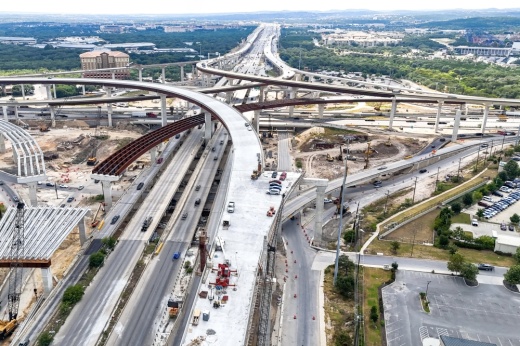The big picture
In the past 25 years, over 91,000 people have died on Texas roads. That is enough people to fill Cotton Bowl Stadium in Dallas, according to TxDOT.
On average, 11 people died daily on Texas roads last year, while in 2025, an average of 10 people had died per day as of Sept. 24.
Texas’ annual traffic fatality rate spiked during the COVID-19 pandemic, which officials attribute to people driving at higher speeds when faced with less traffic. Although fatalities have remained “stubbornly high” in recent years, the annual number of deaths on Texas roads fell from 2022-24 as the state’s population grew.
“[That] is encouraging, because more people are moving here and there are more vehicle miles traveled, which means more people on the road,” TxDOT Media Relations Director Adam Hammons told Community Impact. “Yet, the total traffic fatalities [are] going down, so that does give us hope.”The details
To get a comprehensive view of traffic safety trends and initiatives, Community Impact staff spoke with TxDOT and local agencies in the Austin, Houston, Dallas-Fort Worth and San Antonio areas. Staff also reviewed state and local crash data and roadway safety plans.
“Traffic crashes aren't accidents. They are preventable,” Austin City Council member Vanessa Fuentes said during an Oct. 10 event. “They are a public health crisis, and like any health crisis, they require a direct, holistic response.”
State and local leaders told Community Impact that their teams analyze traffic data to determine when, where and how severe crashes are occurring. They found that the top factors in crashes resulting in serious injuries or deaths include:
- Drunken or impaired driving
- High speeds
- Distracted driving
- Pedestrian and cyclist safety
- Drivers or passengers not wearing seatbelts
- Roadway or lane departures
- Wrong-way driving
Officials also stressed the importance of educating drivers—through public safety campaigns, driver education courses and word of mouth—about dangerous behaviors and risk factors.
Zooming in
Speed and impaired driving are involved in the majority of deadly crashes on Texas roads, data shows. Of the 4,150 total traffic fatalities last year, TxDOT reported that about 35% were speed-related and 25% were caused by drunken drivers.
As people move to Texas from other states or countries, they bring different driving styles and attitudes, Sonya Landrum, a transportation program manager for the North Central Texas Council of Governments, said.
“One thing that is consistent amongst a lot of people, regardless of where they are from, is the component of speeding,” Landrum told Community Impact. “[It] seems like everybody loves to speed, and speeding is one of the top contributing factors for crashes within our region. So more people, more crashes—or more chances to be involved in a crash.”
Texas law also allows higher speed limits than many other states, data shows. Speed limits on state roadways, such as highways and toll roads, must be set at 70 mph unless studies show that a lower speed limit would improve safety, according to TxDOT.
The Texas Transportation Commission, which governs TxDOT, has the authority to set a 75 mph speed limit, and speeds of 80 or 85 mph are allowed on highways that are “designed to accommodate that speed.” A 41-mile stretch of SH 130 south of Austin has a posted speed limit of 85 mph, which is higher than that of any other state, according to data from the Insurance Institute for Highway Safety and Highway Loss Data Institute, or IIHS-HLDI.
“People often drive faster than the speed limit, and if the limit is raised, they will go faster still,” IIHS senior research transportation engineer Raul Avelar wrote in an article on the nonprofit’s website. “Research shows that when speed limits are raised, speeds go up, as do fatal crashes. By the same token, lowering speed limits cuts injury crashes.”
San Antonio Transportation Director Cat Hernandez said it is important for drivers to remember that they cannot control others on the road.
“You can only control yourself when driving,” she told Community Impact. “That’s why it's important that we kind of just take a moment, slow down a little bit, and be aware that there [are] other people. Whether they're driving, whether they're walking, whether they're cycling, they're also sharing that road with you.”
TxDOT’s primary driver safety campaign, which is featured on roadway signs throughout the state, encourages motorists to “Drive Like a Texan.” According to TxDOT, that means being kind, courteous and safe on and off the road.
“If you remember who you are as a Texan, and understand that these are your neighbors, your fellow Texans around you, then that could change your mindset,” Hammons said. “If we want to prevent drunk drivers, just drive like a Texan, because Texans don't do that to other people. Texans think of other people.”
Joel Meyer, a transportation officer with Austin Transportation and Public Works, said that looks like “being a little more empathetic” on the road.
“Recognizing how big of a factor that speed plays in these crashes—just even slowing down five miles an hour can really lower your risk of crash and risk of injury,” he said. “And then just recognizing that everyone out there is trying to get home safely to their family... goes a long way.”

The local impact
As Texas grows and more people hit the road, TxDOT and local transportation authorities are working to meet demand and reduce congestion. Officials told Community Impact that safety is “our top priority” in those projects.
Since 2015, Austin has invested more than $1.3 billion in safety and mobility improvements through three voter-approved mobility bonds, Community Impact previously reported. In 2022, Harris County voters approved three bond propositions totaling $1.2 billion dollars, according to previous reporting. Patrick Mandapaka, the Senior Director of Planning and Development Services for the Harris County Engineer’s office, said Harris County's bonds funded a variety of roadway safety projects and multimodal transportation initiatives.
In North Texas, the NCTCOG’s Regional Transportation Council recently allocated $54 million for local roadway safety improvements, Landrum said. In San Antonio, Hernandez said local officials received $5.5 million from the federal government to construct a set of mid-block crosswalks and other safety measures in 2022.
Despite the trend of roughly 10 deaths per day on Texas roads, Hammons said TxDOT has recorded some days with a single fatality, including a day in January 2024.
“We have not ended the streak yet, but we know we can,” he said. “And the hope is if we do end the streak one day, then maybe we can do two, and then maybe three—we know it is possible. ... We need everyone's help when they get behind the wheel to improve safety and save lives, because the streak has gone on too long, for 25 years.”





